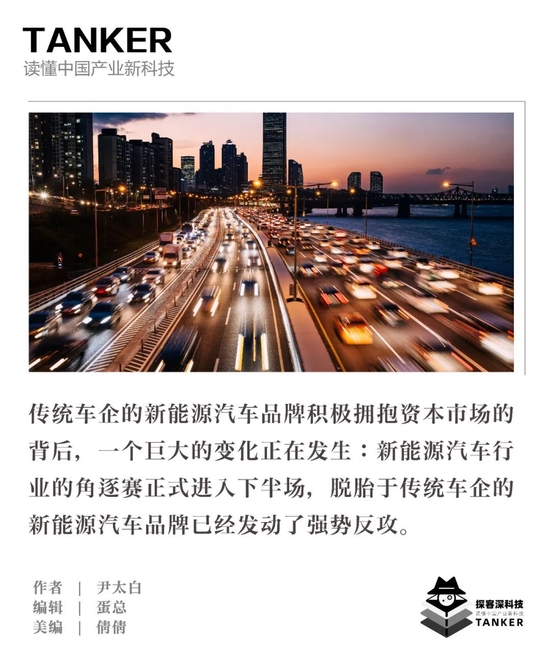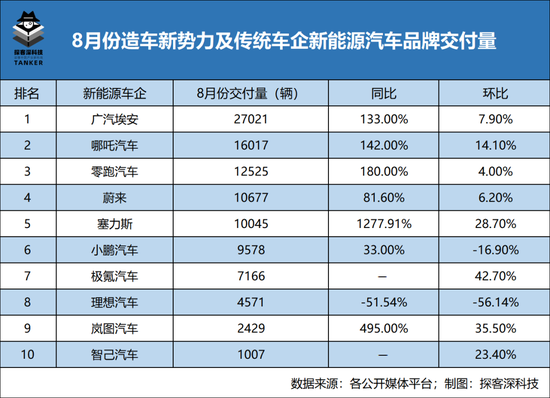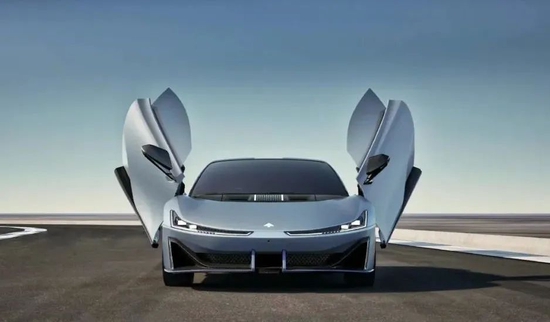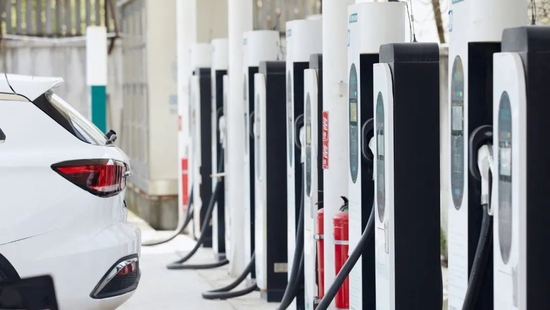
Welcome to the WeChat subscription number of “Sina Technology”: techsina
Text / Yin Taibai
Source: Tankeshen Technology (ID:TKshenkeji)
Recently, GAC AION has made frequent moves. Its new pure electric model AION Y Plus will be officially launched on September 27, with a maximum cruising range of 600km, attracting the attention of many car enthusiasts.
Before that, the more eye-catching news of GAC Aian was that it finally took a substantial step on the road to impact the “first stock of new energy vehicles on the Science and Technology Innovation Board”.
On September 6, “Guangqi Aian New Energy Vehicle Co., Ltd.” officially changed its name to “Guangzhou Aian New Energy Vehicle Co., Ltd.”, although only the word “share” was added after the name change, but in fact GAC Aian’s new energy vehicle Co., Ltd. The nature of the enterprise has undergone major changes, which also means that its mixed ownership reform has been officially completed.
Mixed ownership reform refers to a plan for changing the shareholding structure of non-official capital into state-controlled enterprises, the ultimate goal of which is to enhance the competitiveness, innovation and profitability of enterprises, and to promote sustainable development.
“The mixed ownership reform of GAC Aian is the basic requirement to meet the IPO conditions, and it is also an important focus of the regulatory agency’s review. The completion of the reform means that it has cleared the key obstacles to listing. GAC Aian may open the B round of financing within this year. And the listing on the Science and Technology Innovation Board will be completed between the end of 2023 and the beginning of 2024.” Wang Yinhai, a person in the automobile industry, revealed to ‘Takeshen Technology’.
The mixed ownership reform of GAC Aian started in August 2021. Three months later, it announced the completion of asset restructuring. GAC Group will divest all assets related to new energy vehicles and integrate it into the GAC Aian system to realize the integration of “research, production and sales”. . In March 2022, GAC Aian completed employee equity incentives, and simultaneously introduced Chengtong Group, Nanwang Dynamics, and Guangzhou Aian as strategic investors.
On August 26, GAC Aian’s A round of capital increase project was officially listed on the Guangdong United Assets and Equity Exchange, diluting about 15% of the shares and introducing no more than 70 strategic investors. According to the listed price, the valuation of GAC Aian after the A round of war will exceed 100 billion yuan, which is almost the highest valuation before the IPO of new energy vehicle companies.
In fact, not only GAC Aeon, but also the new energy vehicle brands incubated by traditional car companies at this stage have all released the signal of “solo”.
On September 13, the information on the capital increase project of Lantu Automobile, a new energy vehicle brand of Dongfeng Group, was officially disclosed on the Shanghai United Assets and Equity Exchange. This capital increase was the first external equity financing since the establishment of Lantu Automobile; on August 2, Changan Automobile Co., Ltd. The new energy vehicle brand Avita increased its capital and shares through public listing; on August 1, SAIC Motor announced that its Zhiji Automobile had completed the signing of the A round of equity financing agreement.
Behind the new energy vehicle brands of traditional car companies actively embracing the capital market, a huge change is taking place: the competition in the new energy vehicle industry has officially entered the second half, and the new energy vehicle brands born out of traditional car companies have launched a strong counterattack.
“Wei Xiaoli” lost their power
At present, new car manufacturers and new energy vehicle brands of traditional car companies have announced the delivery data in August. Overall, the August delivery rankings have changed from the previous normal: more and more traditional car companies’ new energy vehicle brands have entered the top ten, while the new car-making forces represented by “Wei Xiaoli” have not. Begin to “abandon the throne and let the virtuous”.
Specifically, GAC Aian, Nezha and Leapmotor occupied the top three places in the August delivery list, and the year-on-year growth rates all exceeded 100%. On the other hand, the performance of “Weixiaoli” was slightly inferior. Among them, the delivery volume of ideal cars was only 4,571 units, a year-on-year decrease of 51.54% and a month-on-month decrease of 56.14%.
In addition, Celis and Lantu Auto, which were born in traditional car companies, have made significant progress in both year-on-year and month-on-month growth rates. 10,045 vehicles were sold, a year-on-year increase of 1,277.91%, and it was the first time that the AITO Quest series achieved a monthly delivery of over 10,000 units.

At least two conclusions can be drawn from the data comparison: first, the first echelon of new car-making forces is falling from the altar, and the delivery volume of the second echelon is rising; second, traditional car companies such as GAC Group, Geely Group and Dongfeng Group are in the The results of the development on the energy car track have initially appeared.
“Although most of the new energy vehicle brands of traditional car companies appeared later than the new car-making forces, and their design language and marketing efforts are not as strong as the latter, they have shown vitality through mixed reform and financing, and are even expected to become new models of traditional car companies. Performance growth point.” Wang Yinhai said to Tankeshen Technology.
Taking GAC Aian as an example, in March 2022, at the GAC Group annual report conference, Feng Xingya, general manager of GAC Group, set three goals: first, GAC Aian should become a leading brand of new energy vehicles; At present, the pattern of “Wei Xiaoli” has been changed to “Ai Xiaowei”; the third is to challenge the sales target of 240,000 vehicles in 2022.
Feng Xingya’s high-profile remarks were once regarded by the outside world as “speaking nonsense”, and the sales target of 240,000 vehicles was an “impossible task”.
Outside doubts are not without reason. In July 2017, the first pure electric model Trumpchi GE3 under GAC Aeon (formerly known as GAC New Energy) was officially launched. If the sales target of 240,000 vehicles can be achieved in 2022, it will be only a short distance from the delivery of its first new energy vehicle. More than five years.
In contrast, Tesla did not exceed 240,000 vehicles until 2018 after it started delivering its first pure electric model in 2008, which lasted nearly ten years.
However, according to GAC Aeon’s performance in 2022, the sales target of 240,000 units is not out of reach.
Following the delivery of more than 25,000 vehicles in July, GAC Aeon’s delivery in August further increased to 27,000 vehicles, far ahead of the new car-making forces such as “Wei Xiaoli”.
From January to August 2022, the delivery volume of GAC Aian reached 152,300 units, a year-on-year increase of 134%. If it can continue to maintain its current status in the upcoming peak sales season, the last two goals of GAC Aion will be possible. accomplish.
But GAC Aian obviously did not devote all its energy to the competition with “Wei Xiaoli”.
On September 15, GAC Aeon released a new LOGO “AI Shenjian”, and launched a new high-end brand Hyper Haobo and the brand’s first pure electric supercar, Hyper SSR. Among them, the pre-sale price of Hyper SSR is 1.286 million yuan, Hyper The pre-sale price of the SSR Ultimate track version is 1.688 million yuan. According to the plan, the Hyper SSR will start mass production and delivery in October 2023.
 Figure / Hyper SSR
Figure / Hyper SSRIt is worth noting that GAC Aian not only launched a new LOGO, but also launched a new luxury product, and even stripped the word “GAC” from the name, showing its determination to change to a certain extent.
2022 is the year of GAC Aeon’s “Great Leap Forward”. Although the delivery volume is enough to dwarf the pack, it has been lingering in the mid-to-low-end market. Therefore, GAC Aeon urgently needs to tell a new story to shake the existing market structure. Change the inherent brand image in the minds of consumers.
“It is not uncommon to use luxury supercars to enhance brand awareness and high-end positioning. Tesla and Weilai have both released similar products, but they have not been delivered in mass production. If GAC Aian can seize the opportunity, it may be possible When the new car-making forces lost their power, they launched the brand name of high-end smart electric vehicles.” Wang Yinhai said.
“In fact, the strength of the new energy vehicle brands of traditional car companies should not be underestimated. Although the new energy vehicle market is experiencing a period of rapid development, the market capacity is limited. The chain control is low, and as traditional car companies gradually spin off their new energy vehicle brands and go public, the difficulties faced by new car manufacturers will only continue to increase.” An auto analyst told ‘Take Deep Technology’.
The trouble of GAC Aian
Although GAC Aeon has grown into a force that cannot be ignored and has a certain say in the new energy vehicle market, the pressure it faces at this stage is still huge.
Prior to this, in order to expand sales, GAC Aion focused on the B-end market such as online car-hailing. However, the high proportion of sales in the B-end market has become a major concern.
At present, GAC Aion’s product line mainly includes five models: AION S, AION S Plus, AION Y, AION LX Plus and AION V Plus. According to the delivery data in August, the delivery volume of AION S was 11,683 units, and the delivery volume of AION Y was 11,012 units. The two models accounted for 84% of the delivery volume of the month.
It should be pointed out that the price range of Aion S is 146,800-179,800 yuan, and the price range of AION Y is 137,600-189,800 yuan, mainly targeting the low-end market, and the delivery of these two models mainly depends on the B-end market. promote.
In 2021, the total delivery volume of GAC AION will be 127,000 vehicles, of which about 43% will be contributed by the B-end market. The delivery volume of the pillar models AION S and AION Y in the B-end market will account for 63.01% and 20.33% respectively.
The drawbacks of GAC Aeon targeting the B-end market are also obvious: on the one hand, GAC Aion’s brand image in the minds of consumers is greatly affected, and eventually becomes an obstacle to its impact on the high-end market; on the other hand, betting on B The end market is more susceptible to the impact of the external environment, which brings many uncertainties to its business development.
In addition, the loss is also the “Sword of Damocles” hanging above GAC Aian’s head.
 Figure / Photo Network, based on VRF protocol
Figure / Photo Network, based on VRF protocolFrom 2019 to 2021, the total revenue of GAC Aion was 5.234 billion yuan, 7.61 billion yuan and 17.265 billion yuan respectively, while the net losses were 621 million yuan, 688 million yuan and 1.389 billion yuan respectively, and the cumulative loss in three years was 2.698 billion yuan. Yuan, compared with “Wei Xiaoli”, GAC Aian’s loss is not serious, but once it is independent from GAC Group to find a way out, its loss may further expand.
Beiqi Blue Valley, which is more similar to GAC Aian, may provide some lessons.
The predecessor of BAIC Blue Valley was BAIC New Energy, which started to operate independently in 2009. In the initial stage, BAIC New Energy mainly focused on the B-end market such as taxis and online car-hailing. From 2013 to 2019, it has won China’s pure electric passenger car for seven consecutive years. Crown with car pins.
In September 2018, BAIC New Energy changed its name to BAIC Blue Valley after its A-share backdoor listing, becoming the “first stock of new energy vehicles in China”. Unfortunately, the business structure of BAIC Blue Valley has not changed with the listing. ——In 2019, its delivery volume reached 150,900 units, and the B-end market contributed about 70%, and most of the best-selling models were also concentrated in the mid-to-low-end market.
In addition, the financial status of Arctic Blue Valley after the listing is also “indescribable”. In 2020, 2021 and the first half of 2022, the net losses of BAIC Blue Valley were 6.48 billion yuan, 5.17 billion yuan and 2.18 billion yuan respectively, accumulatively accumulated in two and a half years. The loss is close to 14 billion yuan.
Due to years of losses, BAIC Blue Valley had to rely on “blood transfusion” to survive. Since the listing of A-shares, BAIC Blue Valley has completed four fixed increments, and the accumulated funds raised are 43.2 billion yuan. In the future, GAC Aian may not escape the same fate after listing.
In addition to being trapped in the B-end market and suffering serious losses, GAC Aeon’s low self-research ratio in the three-electric system, intelligent cockpit, and intelligent driving technology is another major concern.
Taking the three-electric system as an example, the three-electric system can be divided into power battery, motor and electronic control system. Among them, GAC Aeon’s motor suppliers and electric system suppliers are Nidec and GAC Nidec, while the power battery The suppliers are CATL, China Innovation Aviation and Funeng Technology. In contrast, BYD has achieved self-developed and self-produced products in the three-electrical system, so the products are more cost-effective and have larger profit margins.
In the three-electric system, the power battery is particularly important, and its cost often accounts for 40%-60% of the cost of the whole vehicle. GAC Aian also gradually realized the importance of the power battery, and slowly embarked on the road of self-developed power battery.
On the “2022 GAC Technology Day”, GAC Group released a new generation of super-energy lithium iron batteries based on microcrystalline technology. The mass energy density of the battery is increased by 13.5%, the volume energy density is increased by 20%, the low temperature capacity at -20°C is increased by about 10%, and the life of the power battery can reach more than 1.5 million kilometers. The new model, internally code-named A02, is expected to be installed as soon as next year.
“At this stage, although GAC Aeon is facing a lot of pressure and is obviously slower than the new car-making forces in terms of products and technologies, it is based on steady progress, rather than rapid iteration and continuous trial and error.” Wang Yinhai Xiang’ According to Tankeshen Technology’s analysis, “From an objective point of view, GAC Aeon also has many advantages. For example, in terms of channels and production capacity, it is significantly ahead of ‘Weixiaoli’, which started from scratch. However, the biggest challenge for traditional car companies is the mechanism. It is still unknown whether GAC Aeon can successfully complete the change due to the change of culture and culture.”
Opportunities for traditional car companies
In Wang Yinhai’s view, the rapid progress of new car-making forces is inseparable from two reasons: first, the state’s attitude and policy to support the development of the new energy vehicle industry is relatively firm; second, consumers’ acceptance of new energy vehicles is constantly improving , especially the innate sense of technology and fashion of the new car-making forces, which are more easily accepted by consumers.
“At present, it seems that the highlight moment of the new car-making forces seems to come to an end.” Wang Yinhai believes that 2022 is expected to become the year of the full-scale explosion of new energy vehicle brands of traditional car companies. “The second half of the new energy vehicle industry is comprehensive strength. Whoever has a more complete industrial chain and an indestructible sales channel is likely to stand out.”
On September 6, at the 4th Global New Energy and Smart Vehicle Supply Chain Innovation Conference, Miao Wei, Deputy Director of the Economic Committee of the National Committee of the Chinese People’s Political Consultative Conference and former Minister of the Ministry of Industry and Information Technology, said: “The target of the penetration rate of new energy vehicles reaching 25% is likely to be advanced in advance. 3 years, that is, this year.”
Previously, the “New Energy Vehicle Industry Development Plan (2021-2035)” proposed that the penetration rate of China’s new energy vehicles should reach 25% by 2025.
The achievement of the penetration rate target of new energy vehicles ahead of schedule also means that the new energy vehicle brands of traditional car companies are ushering in a window period to break through.
 Figure / Photo Network, based on VRF protocol
Figure / Photo Network, based on VRF protocolThis is indeed the case. In August, the delivery volume of Lantu vehicles continued to rise for 3 consecutive months; Zhiji Automobile joined the delivery volume rankings, and the delivery volume of its first model exceeded 1,000; Extremely Krypton Motors continued to maintain rapid growth.
“One of the development trends of the new energy vehicle brands of traditional car companies is to adopt market-oriented operations and conduct new explorations in terms of concepts, technologies, and products. Become the most powerful competitor of the new car-making forces.” Wang Yinhai judged.
In fact, such a judgment can be seen from the financing of new energy vehicle brands of traditional car companies.
First of all, compared with the new car-making forces, many investors with a background of state-owned capital have joined the ranks of investing in the former. For example, the investors of Avita and Zhiji Auto have the National Green Development Fund. Investors Guangzhou Aian, Chengtong Group and Nanwang Kinetic Energy all have state-owned capital backgrounds.
Secondly, the new energy vehicle brands of traditional car companies are often keen to bind relevant parties in the industry chain. For example, Intel, Ningde Times and Hongshang Group are among the investors of Jikr Auto, and there are investors known as Zhiji Auto. Zhangjiang Hi-Tech of “China’s Silicon Valley”, and Avita also introduced CATL as an investor.
“After the competition in the new energy vehicle industry enters the second half, the competition mode between new car manufacturers and new energy vehicle brands of traditional car companies will shift from confrontation to cooperation.” Wang Yinhai analyzed to ‘Takeshen Technology’, ” At this stage, traditional car companies still have a broad moat, such as quality, manufacturing process, parts adaptation, and chassis tuning, etc., while new car manufacturers are better at intelligence and software. However, cooperation is not unlimited. To be fair, confrontation is still the main purpose, after all, whoever can maintain a technical advantage in the fierce market competition will be able to survive as much as possible in the bloody battle.”
*Note: All names in the text are pseudonyms. The title picture in the article comes from: Photo Network, based on the VRF protocol.

(Disclaimer: This article only represents the author’s point of view and does not represent the position of Sina.com.)
This article is reproduced from: http://finance.sina.com.cn/tech/csj/2022-09-23/doc-imqmmtha8505668.shtml
This site is for inclusion only, and the copyright belongs to the original author.